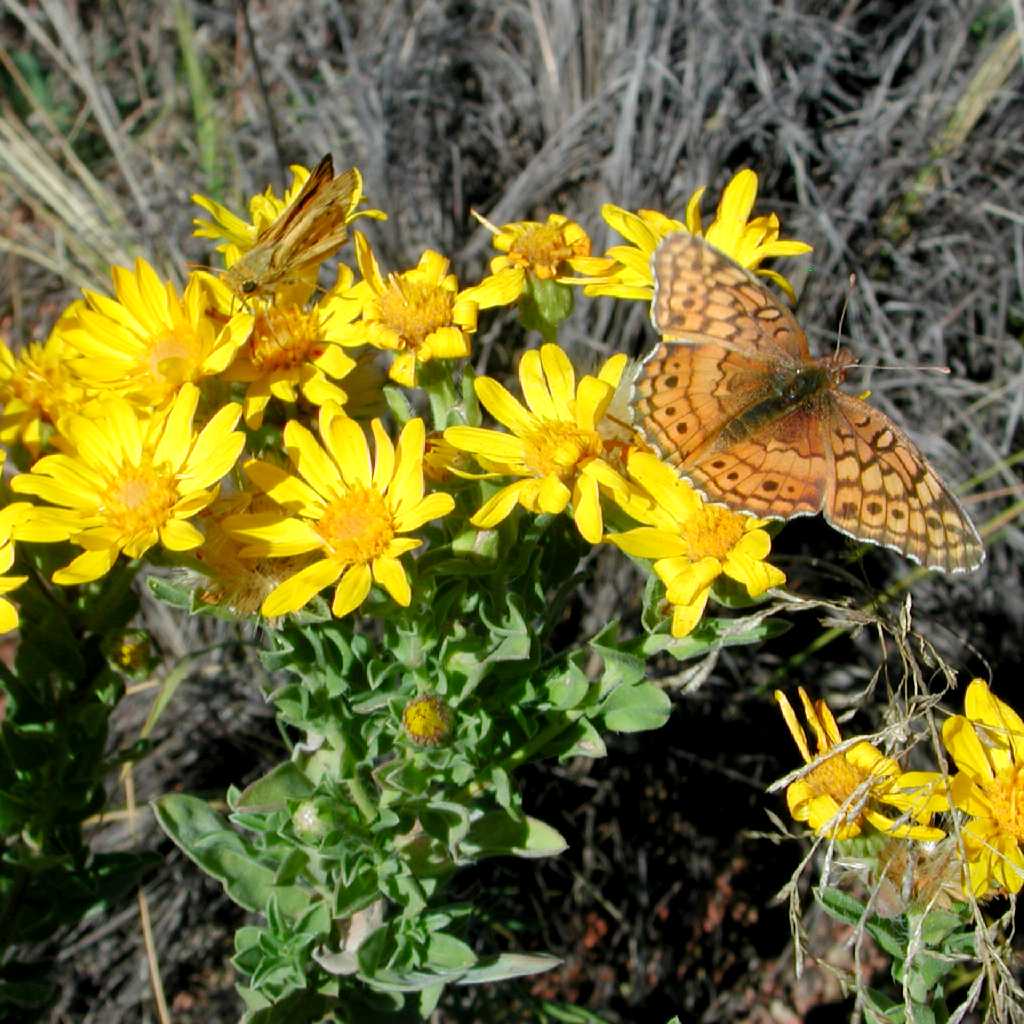
|
Family: Asteraceae |
Annuals or perennials, (5-)30-60(-200) cm (sometimes becoming shrubby through shoot persistence, with camphor odor when leaves moderately to densely stipitate-glandular); stout taprooted or with woody caudices, sometimes also rhizomatous. Stems ascending-erect, branched distally, appressed-strigose and hispid, sparsely to abundantly long-hispid or -hirsute (hairs spreading, long, cells osteolate, walls minutely pustulate). Leaves basal and cauline; petiolate (petiole basal margins always coarsely, spreading-ciliate) or sessile; proximal blades 1-nerved, ovate-oblanceolate (bases tapering), hairy; distal smaller (bases sometimes clasping), margins (sometimes undulate) serrate to entire, faces hispid to strigose, stipitate-glandular. Heads radiate (discoid in H. oregona), borne singly or in corymbiform arrays, sometimes becoming paniculiform. Involucres campanulate to turbinate (campanulo-hemispheric upon drying), (3-14 ×) 3.8-23 mm. Phyllaries 26-80 in 3-5 series, 1-nerved (usually raised; keeled proximally), lanceolate to linear-lanceolate, usually strongly unequal (usually stiff), margins scarious (sometimes distally reddish purple), sparsely to densely strigose (hairs short to long), eglandular to densely stipitate-glandular (usually more densely so distally). Receptacles slightly convex, subulate, pitted, epaleate. Ray florets (4-)30 (0 in H. oregona), pistillate, fertile; corollas yellow (tubes glabrate to short-pilose, laminae usually eglandular, sometimes stipitate-glandular proximally). Disc florets 9-110; corollas yellow, ampliate, tubes shorter than narrowly funnelform throats (glabrate to sparsely, minutely strigose, hairs 0.5-1.5 mm in 2 species, sometimes minutely glandular), lobes 5, erect to spreading, deltate, triangular, or lanceolate; style-branch appendages narrowly triangular. Cypselae sometimes dimorphic, obconic, compressed or not, of ray florets often 3-angled, 4-12-ribbed, faces glabrous or densely strigillose; pappi 0 or in 3-4 series, outer of 3-40 (sometimes obscure) linear to linear-lanceolate or triangular scales (0.2-1 mm), inner of 30-45 off-white, stramineous, or tan to rusty brown, barbellate, apically clavate or attenuate bristles (3-11 mm). x = 9. The generic limits of Heterotheca used here are those of J. C. Semple et al. (1980), who included all goldenasters with stiff, gradually tapering, multicellular hairs with bone-shaped cells with knobby faces, regardless of whether or not they had dimorphic cypselae. Traditionally, only dimorphic species had been included. L. H. Shinners (1951e) found that some individuals of the H. subaxillaris complex sensu G. L. Nesom (1990e) are not consistently dimorphic. He thus proposed merging the genus Chrysopsis, including Pityopsis, into Heterotheca. V. L. Harms (1965) reported cytologic evidence supporting this merger and followed Shinners in subsequent papers (e.g., Harms 1970). Semple (1977) and Semple et al. (1980) presented evidence that Chrysopsis and Pityopsis differ sufficiently to be treated as separate genera based on habit, hair, leaf, cypsela, and cytologic traits. Nesom (2000) recognized Heterotheca as delimited here, following Semple et al. (1980) and Semple (1996). Semple and J. L. A. Hood (2005) showed that the assumed 2-seriate pappus was usually 3- and sometimes 4-seriate, the longest inner series usually weakly clavate apically. The genus is divided into three sections based on ray floret presence or absence, monomorphic or dimorphic cypselae, and, to a lesser extent, leaf traits (J. C. Semple 1996). Heterotheca sect. Heterotheca has dimorphic cypselae: the ray cypselae are usually glabrous and lack pappi. B. L. Wagenknecht (1960) revised section Heterotheca; G. L. Nesom (1990e) proposed an alternative treatment and combined several annual species. The latter is followed here with slight modification: three species are recognized (two in the flora, H. grandiflora and H. subaxillaris). The monospecific sect. Ammodia (Nuttall) V. L. Harms has discoid heads. Semple et al. (1988) revised sect. Ammodia and presented a multivariate analysis of the single species, H. oregona. The large sect. Phyllotheca (Nuttall) V. L. Harms has monomorphic cypselae in radiate heads (with the exception of one Mexican species). Semple (1996) revised sect. Phyllotheca (the C. villosa complex in the broad sense) and summarized data on the goldenaster genera. Species of sect. Phyllotheca are often difficult to distinguish due to a combination of environmentally induced plasticity, overlap in ranges of characters, and subtlety o Much like Chrysopsis, but the ray-achenes thick, commonly 3-angled, glabrous or nearly so, without pappus; annual or biennial, hairy herbs. 3-5, N. Amer. Gleason, Henry A. & Cronquist, Arthur J. 1991. Manual of vascular plants of northeastern United States and adjacent Canada. lxxv + 910 pp. ©The New York Botanical Garden. All rights reserved. Used by permission. |
This project was made possible in part by the Institute of Museum and Library Services [MG-70-19-0057-19].
Powered by Symbiota



